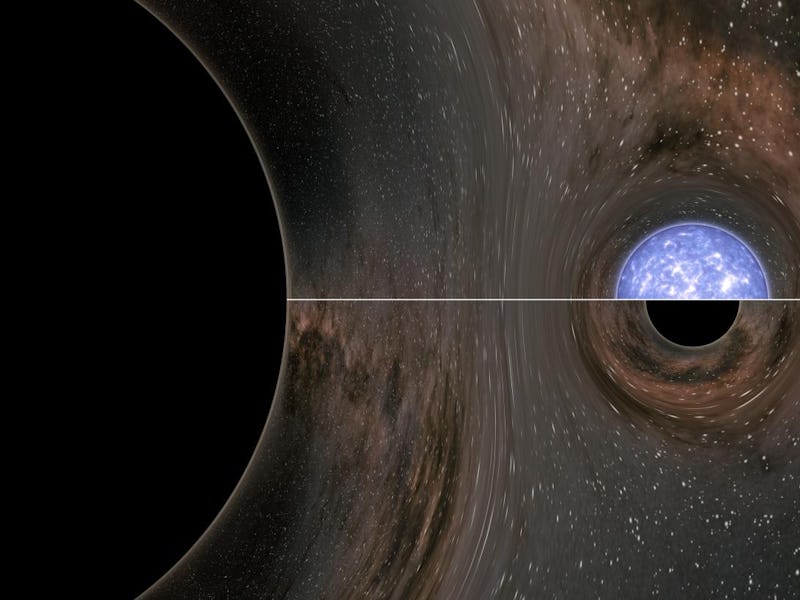Is it a neutron star or black hole? Astronomers are confused by this mysterious object
A recently detected object falls in the 'mass gap.'

On August 14, 2019, astronomers discovered evidence of something mysterious they're only starting to understand.
It started with gravitational waves, which were detected by observatories in Washington and Italy. The signal of those waves a result of two massive cosmic objects crashing and then merging into one another — a black hole that's about 23 times as massive as the Sun and a second mysterious object of 2.6 solar masses.
The object in question remains unclassified as it falls within an elusive mass gap which makes it either the lightest known black hole or the heaviest known neutron star.
The detection of the mysterious object is detailed in a study published this week in The Astrophysical Journal Letters.
Neutron stars form from the dense remains of a dead star.
The death of stars can result in two objects; black holes or neutron stars. As a star nears the end of its life, it runs out of fuel and collapses under the weight of its own gravity. The larger stars leave behind a black hole, a great amount of matter packed into a tight area of space, while the remnants of slightly smaller stars create neutron stars, an extremely dense, dead core of a star.
The lightest black hole is about five times the mass of the Sun, while the heaviest neutron stars are 2.5 times the mass of the Sun.
However, this newly discovered object is 2.6 times the mass of the Sun, which makes it neither a light black hole nor a heavy neutron star. Instead, it exists in the yet undefined 'mass gap' between the two objects.
"Even though we can't classify the object with conviction, we have seen either the heaviest known neutron star or the lightest known black hole," Vicky Kalogera, a professor of physics and astronomy at Northwestern's Weinberg College of Arts and Sciences, who coordinated the writing of the new paper, said in a statement. "Either way, it breaks a record."
This so-called mass gap has intrigued astronomers for decades, but this discovery marks the first time an object fits right into the gap between black holes and neutron stars.
The merger of this mysterious object with the larger black hole was detected by the National Science Foundation's Laser Interferometer Gravitational-Wave Observatory (LIGO) and the European Virgo observatory, and dubbed GW190814.
A graph showing the detection of gravitational waves from the merger of black holes, with this recent event marked right in the middle.
The merger resulted in a black hole that's about 25 times the mass of the Sun, located around 800 million light-years away from Earth.
Before they merged, the masses of the two objects differed by a factor of nine which made this merging event the most extreme mass ratio of any gravitational wave event detected.
"I think of Pac-Man eating a little dot," Kalogera said. "When the masses are highly asymmetric, the smaller compact object can be eaten by the black hole in one bite."
However, the researchers behind the new study believe that this type of merger could occur a lot more frequently than previous models have predicted.
Although astronomers are not able to define this freak of nature just yet, they are hoping that future observations of similar merger events or of objects that fit into this odd mass gap will help them identify whether the mysterious object is a black hole or neutron star.
"This observation is yet another example of the transformative potential of the field of gravitational-wave astronomy, which brings novel insights to light with every new detection," Pedro Marronetti, program director for gravitational physics at the National Science Foundation, said in a statement. "[It] cannot be explained without defying our understanding of extremely dense matter or what we know about the evolution of stars."
Abstract: We report the observation of a compact binary coalescence involving a 22.2–24.3 M⊙ black hole and a compact object with a mass of 2.50–2.67 M⊙ (all measurements quoted at the 90% credible level). The gravitational-wave signal, GW190814, was observed during LIGO's and Virgo's third observing run on 2019 August 14 at 21:10:39 UTC and has a signal-to-noise ratio of 25 in the three-detector network. The source was localized to 18.5 deg2 at a distance of Mpc; no electromagnetic counterpart has been confirmed to date. The source has the most unequal mass ratio yet measured with gravitational waves, , and its secondary component is either the lightest black hole or the heaviest neutron star ever discovered in a double compact-object system. The dimensionless spin of the primary black hole is tightly constrained to ≤0.07. Tests of general relativity reveal no measurable deviations from the theory, and its prediction of higher-multipole emission is confirmed at high confidence. We estimate a merger rate density of 1–23 Gpc−3 yr−1 for the new class of binary coalescence sources that GW190814 represents. Astrophysical models predict that binaries with mass ratios similar to this event can form through several channels, but are unlikely to have formed in globular clusters. However, the combination of mass ratio, component masses, and the inferred merger rate for this event challenges all current models of the formation and mass distribution of compact-object binaries.